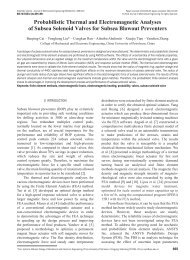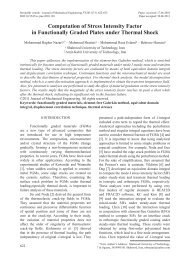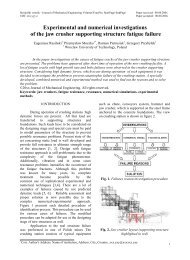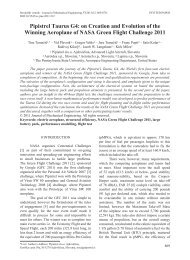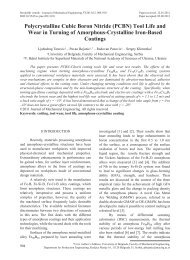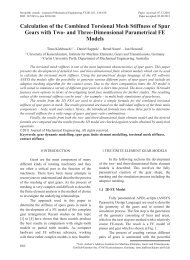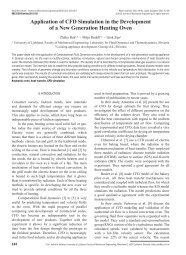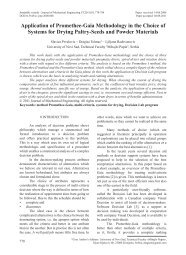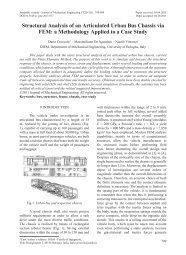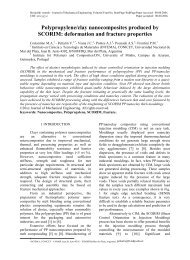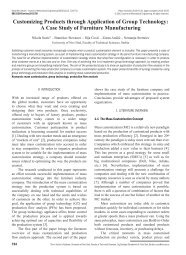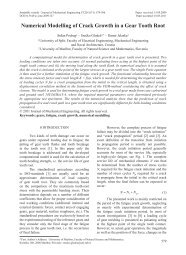Simulation of Water-Gas Shift Membrane Reactor for Integrated ...
Simulation of Water-Gas Shift Membrane Reactor for Integrated ...
Simulation of Water-Gas Shift Membrane Reactor for Integrated ...
- No tags were found...
Create successful ePaper yourself
Turn your PDF publications into a flip-book with our unique Google optimized e-Paper software.
Strojniški vestnik - Journal <strong>of</strong> Mechanical Engineering 57(2011)12, 911-926reaction temperatures, at which the equilibriumCO conversion would otherwise be low, byextracting either CO 2 or H 2 from the reactionmixture.1.3 <strong>Water</strong>-<strong>Gas</strong> <strong>Shift</strong> Kinetics1.3.1 General Definition <strong>of</strong> Rate LawChemical kinetics investigates howdifferent experimental conditions can influencethe chemical reaction rate. The main factors thatcan speed up the reaction rate include increasein the concentrations <strong>of</strong> the reactants, increasein temperature or pressure at which the reactionoccurs and whether or not any catalysts are presentin the reaction.Usually, what appears to be a single stepconversion is in fact a multistep reaction and thus,the reaction mechanism is a step by step sequence<strong>of</strong> elementary reactions. Each step has its ownrate law and molecularity (the number <strong>of</strong> speciestaking part in that step); there<strong>for</strong>e the slowest stepis the one that determines the overall reactionrate – the rate limiting step.Only <strong>for</strong> simple (elementary) reactionsa partial order <strong>of</strong> reaction is the same as thestoichiometric number <strong>of</strong> the reactant concerned.For stepwise reactions there is no generalconnection between stoichiometric numbers andpartial orders. Such reactions may have morecomplex rate laws and the orders <strong>of</strong> reaction are inprinciple always assigned to the elementary steps.By conducting experiments involvingreactants A and B, one would find that the rate <strong>of</strong>the reaction r is related to the concentrations [A]and [B] in a rate law as:r = k [A] a [B] b , (2)where k is the rate constant and the powers a andb are called the partial orders <strong>of</strong> the reaction. Theoverall order <strong>of</strong> the reaction is found by adding upthe partial orders. The rate constant is not a trueconstant because it is dependent on the reaction’stemperature T and the activation energy E a and isdefined via Arrhenius equation as:Ea−k = k ⋅eRT ⋅0 , (3)where k 0 is the pre-exponential factor.A pair <strong>of</strong> <strong>for</strong>ward and backward reactionsmay define an equilibrium process where A and Breact into C and D and vice versa (a, b, c and d arethe stoichiometric coefficients):aA+ bB ⇔ cC+ d D(4)Assuming that above reactions areelementary, the reaction rate can be expressed as:r = k 1·[A] a·[B] b ‒ k 2·[C] c·[D] d , (5)where k 1 is the rate coefficient <strong>for</strong> the <strong>for</strong>wardreaction which consumes A and B; k 2 is the ratecoefficient <strong>for</strong> the backward reaction, whichconsumes C and D.In a reversible reaction, like WGSR,chemical equilibrium is reached when the rates <strong>of</strong>the <strong>for</strong>ward and backward reactions are equal andthe concentrations <strong>of</strong> the reactants and products nolonger change (r = 0 in balance).1.3.2 Brad<strong>for</strong>d Mechanisma) Backward WGSRBrad<strong>for</strong>d [4] assumed that the reactionmechanism would follow the simple gas-phasechain-reaction mechanism given below (Mindicates any gas-phase collision partner). Thechain is initiated by the gas-phase dissociation<strong>of</strong> hydrogen (Eq. (6)). Propagation steps arerepresented by reactions in Eqs. (7) and (8). Thetermination step corresponds to the gas-phase reassociation<strong>of</strong> H 2 in Eq. (9), consuming the chaincarriers.H2k1+ M ⎯⎯ →2H+M, (6)2H+ CO ←⎯⎯⎯⎯ →CO+OH, (7)2k−2k2 k2k3OH + H ←⎯⎯⎯⎯ →H O+H, (8)−3k−12 MH+ ⎯⎯ →H 2 + M. (9)With the assumption <strong>of</strong> low conversionand a stationary state <strong>for</strong> the concentrations <strong>of</strong>the intermediates (H and OH concentrations donot change significantly with respect to time), thefollowing rate equation r b is obtained,rdCOdtkk[ ] b = = ⎛ ⎝ ⎜ 1⎞−112 /12 /⎟ ⋅k2⋅[ H2] ⋅[ CO2]. (10)⎠914 Lotrič, A. ‒ Sekavčnik, M. ‒ Kunze, C. ‒ Splieth<strong>of</strong>f, H.



